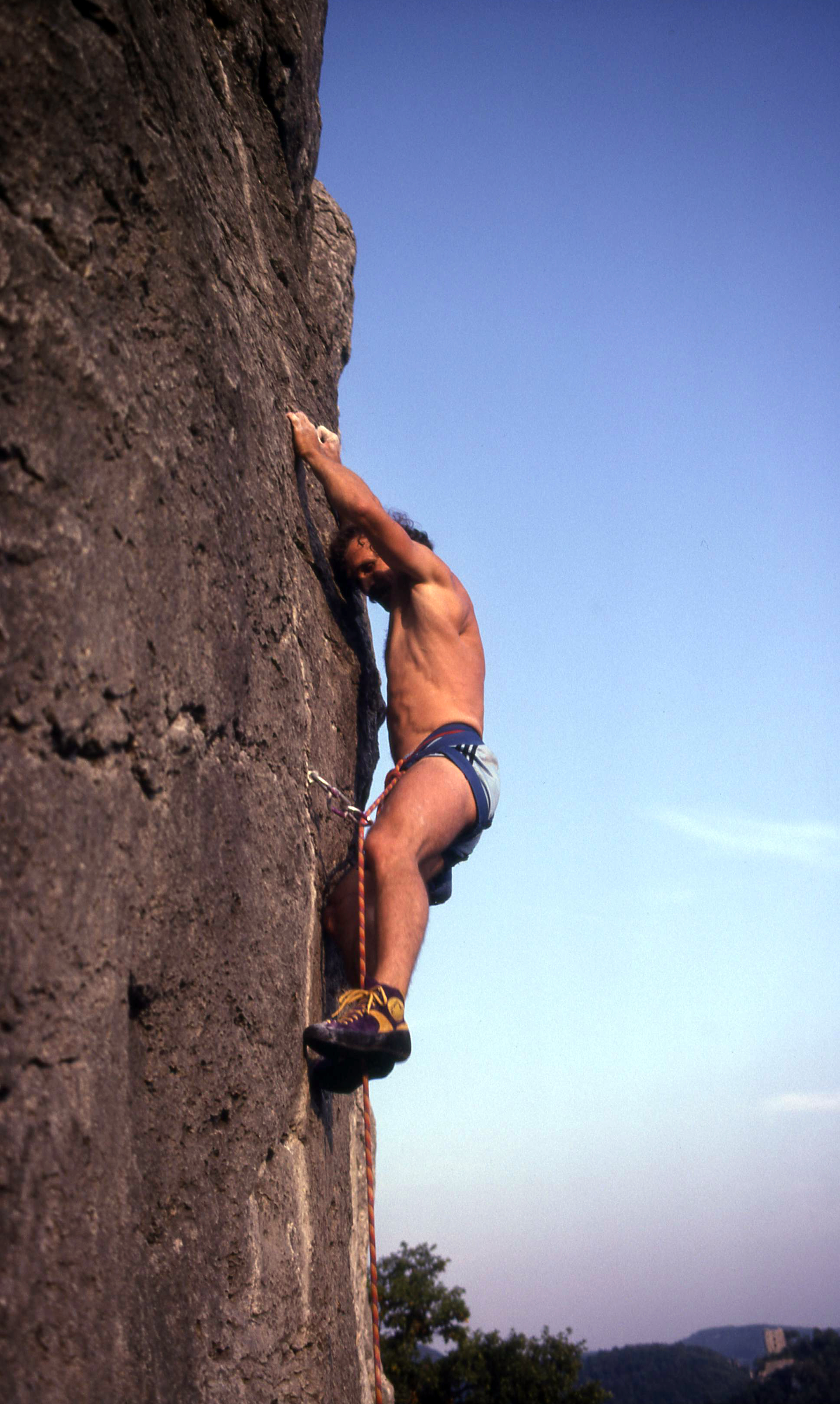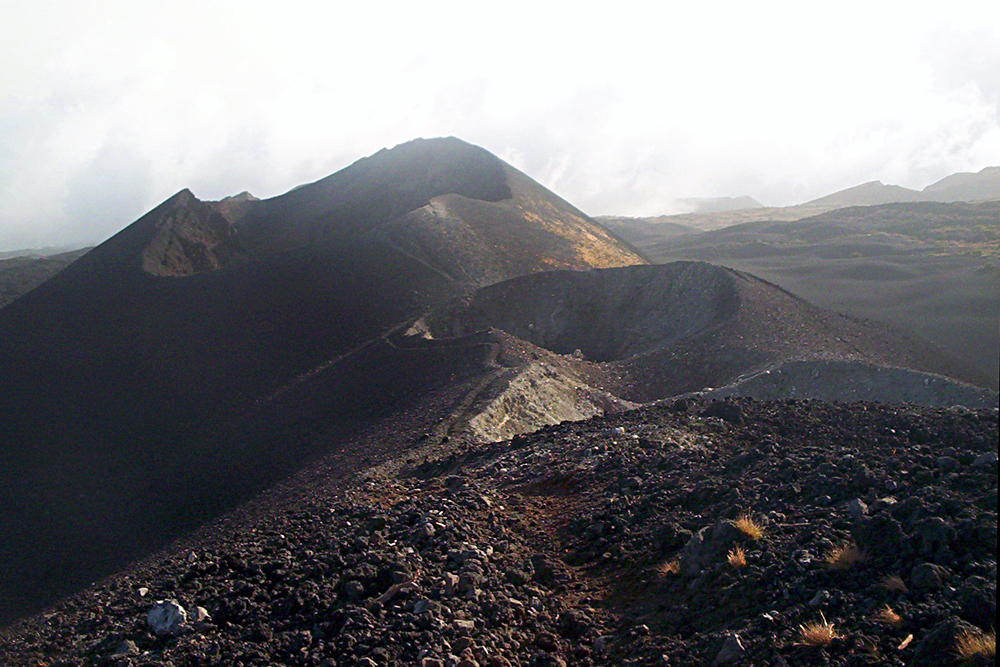|
Pico Cão Grande
The Pico Cão Grande (Portuguese language, Portuguese for "Great Dog Peak") is a landmark needle-shaped volcanic plug peak in São Tomé and Príncipe, in the Caué District of São Tomé Island in Parque Natural Obô de São Tomé. Its summit is above sea level, and it rises about over the surrounding terrain. The volcanic plug was formed by magma solidifying in the vent of an active volcano. The nearest village is Vila Clotilde, 3 km to the east. The district seat São João dos Angolares is 9 km to the east. Geology The volcanic plug is quite a recent phenomenon, having formed as part of the Cameroon line of volcanoes roughly three and a half million years ago in the Pliocene. Its composition is mainly phonolite (also called clinkstone in vernacular English). Rock climbing The moss growing on the rocks due to high moisture content, and the presence of snakes, make climbing here very difficult. The first attempt to climb Pico Cão Grande was made in 1975 by a ... [...More Info...] [...Related Items...] OR: [Wikipedia] [Google] [Baidu] |
Volcanic Plug
A volcanic plug, also called a volcanic neck or lava neck, is a volcano, volcanic object created when magma hardens within a Volcanic vent, vent on an active volcano. When present, a plug can cause an extreme build-up of high gas pressure if rising Volatile (astrogeology)#Igneous petrology, volatile-charged magma is trapped beneath it, and this can sometimes lead to an explosive eruption. In a plinian eruption the plug is destroyed and ash is ejected. Glaciation, Glacial erosion can lead to exposure of the plug on one side, while a long slope of material remains on the opposite side. Such landforms are called crag and tail. If a plug is preserved, erosion may remove the surrounding rock while the erosion-resistant plug remains, producing a distinctive upstanding landform. Examples of volcanic plugs Africa Near the village of Rhumsiki in the Far North Region (Cameroon), Far North Province of Cameroon, Kapsiki Peak is an example of a volcanic plug and is one of the most phot ... [...More Info...] [...Related Items...] OR: [Wikipedia] [Google] [Baidu] |
São Tomé Island
São Tomé Island, at , is the largest island of São Tomé and Príncipe and is home in May 2018 to about 193,380 or 96% of the nation's population. The island is divided into six districts of São Tomé and Príncipe, districts. It is located 2 km (1¼ miles) north of the equator. Geography São Tomé Island is about long (north-south) by wide (east-west). It rises to at Pico de São Tomé and includes the capital city, São Tomé, on the northeast coast. It is situated in the Gulf of Guinea, off the western equatorial coast of Africa. The nearest city on mainland Africa is the port city of Port Gentil in Gabon located to the east. The island is surrounded by a number of small islands, including Ilhéu das Rolas, Ilhéu das Cabras and Ilhéu Gabado. Languages The main language is Portuguese language, Portuguese, but there are many speakers of Forro language, Forro and Angolar language, Angolar (Ngola), two Portuguese-based creole languages. The name "" is Portuguese for ... [...More Info...] [...Related Items...] OR: [Wikipedia] [Google] [Baidu] |
Volcano
A volcano is commonly defined as a vent or fissure in the crust of a planetary-mass object, such as Earth, that allows hot lava, volcanic ash, and gases to escape from a magma chamber below the surface. On Earth, volcanoes are most often found where tectonic plates are diverging or converging, and because most of Earth's plate boundaries are underwater, most volcanoes are found underwater. For example, a mid-ocean ridge, such as the Mid-Atlantic Ridge, has volcanoes caused by divergent tectonic plates whereas the Pacific Ring of Fire has volcanoes caused by convergent tectonic plates. Volcanoes resulting from divergent tectonic activity are usually non-explosive whereas those resulting from convergent tectonic activity cause violent eruptions."Mid-ocean ridge tectonics, volcanism and geomorphology." Geology 26, no. 455 (2001): 458. https://macdonald.faculty.geol.ucsb.edu/papers/Macdonald%20Mid-Ocean%20Ridge%20Tectonics.pdf Volcanoes can also form where there is str ... [...More Info...] [...Related Items...] OR: [Wikipedia] [Google] [Baidu] |
Iker En El L3-8b+ De "Leve,Leve", Cao Grande
Iker is a Basque male given name. The corresponding female name is Ikerne. It was created by the Spanish Basque writer Sabino Arana in his book ' (''Collection of Basque Saints' Names'')—an effort to provide neologistic Basque versions of names instead of the traditional adaptations of Romance names. The name may refer to: People First name *Iker Begoña (born 1976), Spanish footballer * Iker Bilbao (born 1996), Spanish footballer * Iker Bravo (born 2005), Spanish footballer * Iker Camaño (born 1979), Spanish cyclist * Iker Casas (born 1999), Mexican taekwondo practitioner *Iker Casillas (born 1981), Spanish footballer * Iker Flores (born 1976), Spanish cyclist *Iker Gabaraín (born 1977), Spanish footballer *Iker Guarrotxena (born 1992), Spanish footballer *Iker Hernández (born 1994), Spanish footballer * Iker Iturbe (born 1976), Spanish basketball player *Iker Jiménez (born 1973), Spanish journalist *Iker Lecuona (born 2000), Spanish motorcycle racer *Iker Leonet (born 198 ... [...More Info...] [...Related Items...] OR: [Wikipedia] [Google] [Baidu] |
Redpoint (climbing)
In rock climbing, a redpoint is the free-climb of a climbing route by lead climbing. The lead climber cannot use any artificial aid—including their climbing protection—to hold their weight during the climb. If they fall, they cannot place any of their weight on the rope, and hangdogging is not allowed. The lead climber can have attempted or practised the route many times beforehand, such as by headpointing or by top roping. Climbers will try to redpoint a route after having failed to onsight the route, which means to free-climb a route on the first attempt with no falls and no prior beta, or to flash the route, which means to free-climb the route on the first attempt with no falls but with prior beta. The first successful redpoint of a climbing route, in the absence of any prior onsight or flash, is recorded as the first free ascent (FFA) of that route. Description When a climber attempts to redpoint a climbing route, it doesn't matter how many times that they have prev ... [...More Info...] [...Related Items...] OR: [Wikipedia] [Google] [Baidu] |
Sport Climbing
Sport climbing (or bolted climbing) is a type of free climbing in the sport of rock climbing where the Lead climbing, lead climber clips their climbing rope, rope — via a quickdraw — into pre-drilled in-situ bolt (climbing), bolts for their protection (climbing), protection as they ascend the climbing routes, route. Sport climbing differs from the riskier and more demanding traditional climbing where the lead climber must also find places into which temporary protection equipment can be inserted as they ascend the route. Sport climbing dates from the early 1980s when leading French rock climbers wanted to climb blanker face climbing routes that offered none of the crack climbing, cracks into which temporary protection equipment could be inserted. While bolting natural rock faces was controversial—and remains a focus of debate in climbing ethics—sport climbing grew rapidly in popularity; all subsequent List of grade milestones in rock climbing, grade milestones in rock c ... [...More Info...] [...Related Items...] OR: [Wikipedia] [Google] [Baidu] |
Phonolite
Phonolite is an uncommon shallow intrusive or extrusive rock, of intermediate chemical composition between felsic and mafic, with texture ranging from aphanitic (fine-grained) to porphyritic (mixed fine- and coarse-grained). Phonolite is a variation of the igneous rock trachyte that contains nepheline or leucite rather than quartz. It has an unusually high (12% or more) Na2O + K2O content, defining its position in the TAS classification of igneous rocks. Its coarse grained (phaneritic) intrusive equivalent is nepheline syenite. Phonolite is typically fine grained and compact. The name ''phonolite'' comes from the Ancient Greek meaning "sounding stone" due to the metallic sound it produces if an unfractured plate is hit; hence, the English name ''clinkstone'' is given as a synonym. Formation Unusually, phonolite forms from magma with a relatively low silica content, generated by low degrees of partial melting (less than 10%) of highly aluminous rocks of the lower crust su ... [...More Info...] [...Related Items...] OR: [Wikipedia] [Google] [Baidu] |
Pliocene
The Pliocene ( ; also Pleiocene) is the epoch (geology), epoch in the geologic time scale that extends from 5.33 to 2.58See the 2014 version of the ICS geologic time scale million years ago (Ma). It is the second and most recent epoch of the Neogene Period in the Cenozoic, Cenozoic Era. The Pliocene follows the Miocene Epoch and is followed by the Pleistocene Epoch. Prior to the 2009 revision of the geologic time scale, which placed the four most recent major glaciations entirely within the Pleistocene, the Pliocene also included the Gelasian Stage, which lasted from 2.59 to 1.81 Ma, and is now included in the Pleistocene. As with other older geologic periods, the Stratum, geological strata that define the start and end are well-identified but the exact dates of the start a ... [...More Info...] [...Related Items...] OR: [Wikipedia] [Google] [Baidu] |
São João Dos Angolares
São João dos Angolares is a small town on the east coast of São Tomé Island in São Tomé and Príncipe. It is the seat of Caué District. Its population is 3,605 (2012).São Tomé and Príncipe www.citypopulation.de The town lies 17 km southwest of , 17 km northeast of and 24 km southwest of the capital . The Portuguese-based |
Cameroon Line
The Cameroon line (, , ) is a long chain of volcanoes that includes islands in the Gulf of Guinea and mountains on the African mainland, from Mount Cameroon on the coast towards Lake Chad on the northeast. They form a natural border between eastern Nigeria and the West Region of Cameroon. The islands, which span the equator, have tropical climates and are home to many unique plant and bird species. The mainland mountain regions are much cooler than the surrounding lowlands, and also contain unique and ecologically important environments. The Cameroon volcanic line is geologically unusual in extending through both the ocean and the continental crust. Various hypotheses have been advanced by different geologists to explain the line. Geography In the Gulf of Guinea, the Cameroon line consists of six offshore volcanic swells that have formed islands or seamounts. From the southwest to the northeast the island groups are Annobón (or Pagalu), São Tomé, Príncipe and Bioko. T ... [...More Info...] [...Related Items...] OR: [Wikipedia] [Google] [Baidu] |
São Tomé And Príncipe
São Tomé and Príncipe, officially the Democratic Republic of São Tomé and Príncipe, is an island country in the Gulf of Guinea, off the western equatorial coast of Central Africa. It consists of two archipelagos around the two main islands of São Tomé and Príncipe, about apart and about off the northwestern coast of Gabon. With a population of 201,800 (2018 official estimate),Instituto Nacional de Estadística de São Tomé e Príncipe, as of 13 May 2018. São Tomé and Príncipe is the second-smallest and second-least populous African sovereign state after Seychelles. The islands were uninhabited until Portuguese explorers João de Santarém and Pedro Escobar became the first Europeans to discover them in 1470. Gradually colonized and settled throughout the 16th century, they collectively served as a vital commercial and trade centre for the Atlantic slave trade. The rich volcanic soil and proximity to the equator made São Tomé and Príncipe ideal for sugar ... [...More Info...] [...Related Items...] OR: [Wikipedia] [Google] [Baidu] |





